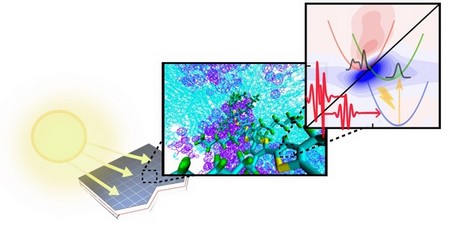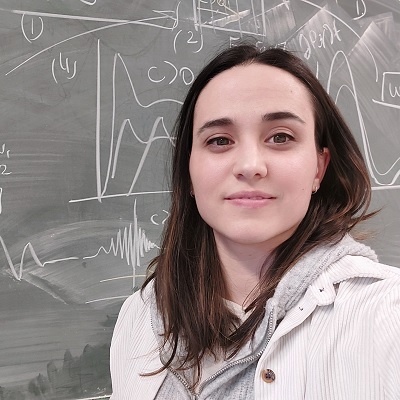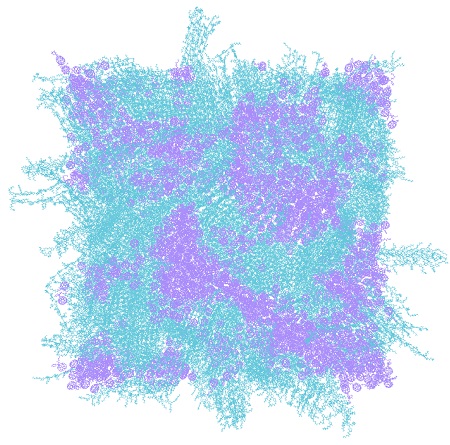Supersnel ladingstransport in organische zonnecellen zichtbaar gemaakt
In organische zonnecellen zetten op koolstof gebaseerde polymeren licht om in elektrische ladingen, die worden doorgegeven aan een acceptor. Dit materiaal heeft allerlei mogelijke toepassingen, maar om die te realiseren is het nodig te weten hoe ladingen zich precies door de polymeren bewegen. RUG-onderzoekers hebben dit nu uitgerekend door een combinatie van Moleculaire Dynamica simulaties en kwantumberekeningen. De theoretische inzichten die dit oplevert zijn 15 maart gepubliceerd in het Journal of Physical Chemistry C.
Organische zonnecellen zijn dunner dan de standaard silicium cellen, flexibel en vermoedelijk eenvoudiger te produceren. Maar om hun efficiëntie verder te verbeteren is het belangrijk te begrijpen hoe ladingen door de polymeerfilm gaan. ‘Deze films bestaan uit een elektronendonor en een acceptor’, legt Elisa Palacino-González uit. Zij is postdoc in de groep Theorie van Gecondenseerde Materie van het Zernike Institute for Advanced Materials van de RUG. ‘De ladingen zijn gedelokaliseerd over de met elkaar vervlochten polymeerketens, waar ze op een tijdschaal van onder de honderd femtoseconden van donor naar acceptor gaan. Daarom hebben we theoretisch onderzoek nodig om dit proces te begrijpen.’

Ladingsoverdracht
Het systeem dat Palacino-González gebruikt bestaat uit de plastic halfgeleider P3HT als donor en als acceptor de polymeer PCBM, waar een C60 ‘buckybal’ aan zit. ‘We wilden weten hoe de geleiding van de lading door het materiaal plaatsvindt, om te begrijpen hoe het energie opvangt en transporteert. Wanneer we dat snappen, kunnen we het hopelijk verbeteren.’ Experimenteel onderzoek van dit materiaal heeft wel wat informatie opgeleverd, maar alleen op een relatief grote schaal. ‘Daarom hebben we Moleculaire Dynamica simulaties gebruikt om te bepalen hoe de moleculen bewegen. Dit combineren we met kwantumchemie berekeningen, waarmee het mogelijk is het donor polymeer op atomaire schaal te modelleren. Daarbij gebruikten wij een techniek die Time-Dependent Density Functional Theory heet.’
Dit theoretische onderzoek is uitgevoerd met een donor polymeer dat bestaat uit twaalf monomeren. ‘We richtten ons vooral op de donor, om daarin te bestuderen hoe in dit materiaal een aangeslagen toestand ontstaat.’ De moleculaire dynamica simulaties laten de door warmte veroorzaakte beweging van het materiaal in de grondtoestand zien. Palacino-González berekende die voor een periode van 12,5 picoseconde, wat genoeg is om de ladingsoverdracht (die op een schaal van femtoseconden plaatsvindt) te bestuderen.

Vingerafdruk
‘De volgende stap was om de kwantumwereld over deze moleculen heen te plaatsen’, vertelt Palacino-González. Hiervoor begon ze met dimeren. ‘Twee monomeren naast elkaar in de polymeerketen gaan een interactie aan, ze “praten” met elkaar. Daardoor splitst het energieniveau van het duo.’ Zij maakte een “vingerafdruk” van de energie van een dimeer in de vorm van een Hamiltoniaan, een matrix die alle informatie bevat over een moleculair systeem. ‘Wanneer twee monomeren parallel aan elkaar zijn uitgelijnd, zijn ze gekoppeld en kunnen ze praten. Maar als er één monomeer in een hoek van 90 graden ten opzichte van de ander staat is de interactie minimaal.’
Zo’n hoek tussen twee monomeren veroorzaakt een knik in de polymeerketen die de doorgifte van energie verstoort. ‘Een statistische analyse van het gesimuleerde materiaal, dat bestond uit 845 polymeren, laat zien dat ongeveer de helft ervan keurig recht is, terwijl in de andere helft knikken zitten, doorgaans een of twee’, vertelt Palacino-González. Vanuit de dimeren berekende zij de Hamiltoniaan van de 12-meren (bestaande uit zes dimeren). Haar berekeningen gingen uit van een variabel aantal knikken in de 12 monomeren lange donorpolymeren. ‘Dit onderzoek laat de energieverdeling langs de polymeren zien en geeft ons een realistisch model om te karakteriseren wat het effect is van het materiaal op de spectra in de acceptor polymeren, zodat we dit kunnen vergelijken met de resultaten van experimenten met deze polymeren.’

Experimenten
Hoewel het model beperkt is tot interacties tussen monomeren die direct naast elkaar in de polymeerketen zitten kunnen de resultaten belangrijk zijn voor de interpretatie van experimentele resultaten. ‘Onze berekeningen gaan uit van fundamentele principes, zonder aannamen. Het is de eerste keer dat zo’n analyse gemaakt is voor dit soort materiaal, en dan ook nog met een realistische beschrijving van de polymeren-mix. Hiermee kunnen we nu helpen om de spectra te verklaren uit experimenten met P3HT/PCBM mengsels. Zo kunnen we bijvoorbeeld laten zien hoe verschillende lengtes de spectra die ontstaan door laserlicht veranderen’, aldus Palacino-González. ‘We zijn nu in staat om te kijken naar ultrasnelle ladingsoverdracht van donor naar acceptor. Dit maakt nieuwe theoretische studies naar organische zonnecellen mogelijk en helpt om de resultaten van experimenten beter te begrijpen.’
Referentie: Elisa Palacino-González and Thomas L. C. Jansen: Modeling the Effect of Disorder in the Two-Dimensional Electronic Spectroscopy of Poly-3-hexyltiophene in an Organic Photovoltaic Blend: A Combined Quantum/Classical Approach. Journal of Physical Chemistry C, 15 maart 2023.
Meer nieuws
-
19 december 2025
Mariano Méndez ontvangt Argentijnse RAÍCES-prijs
-
18 december 2025
Waarom innoveren, en voor wie?
-
17 december 2025
Ben Feringa wint Feynmanprijs

